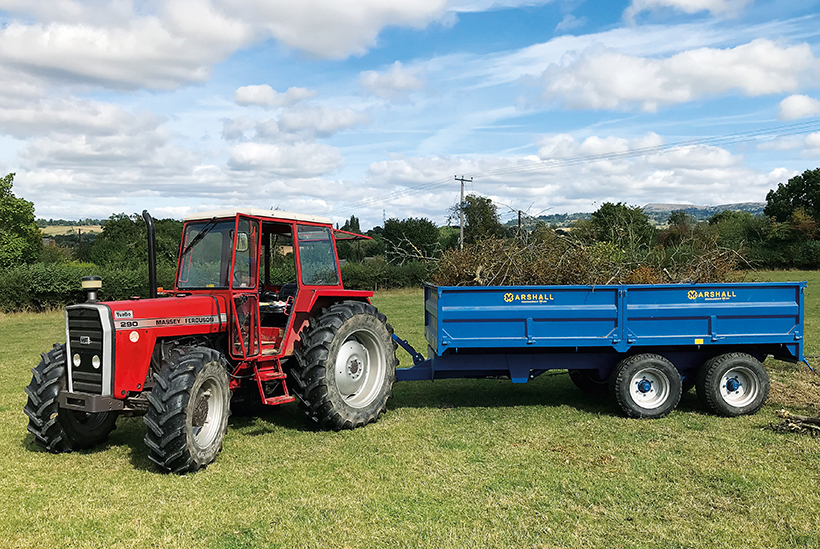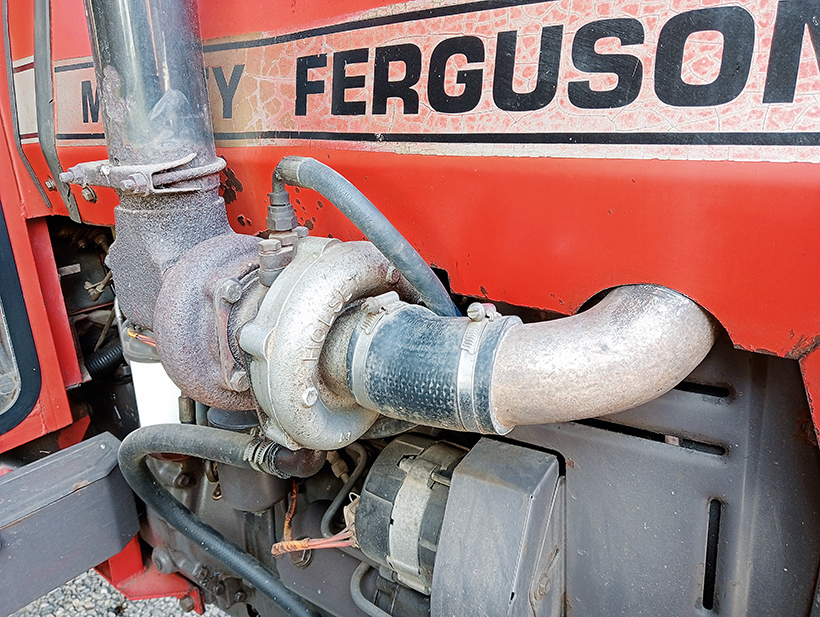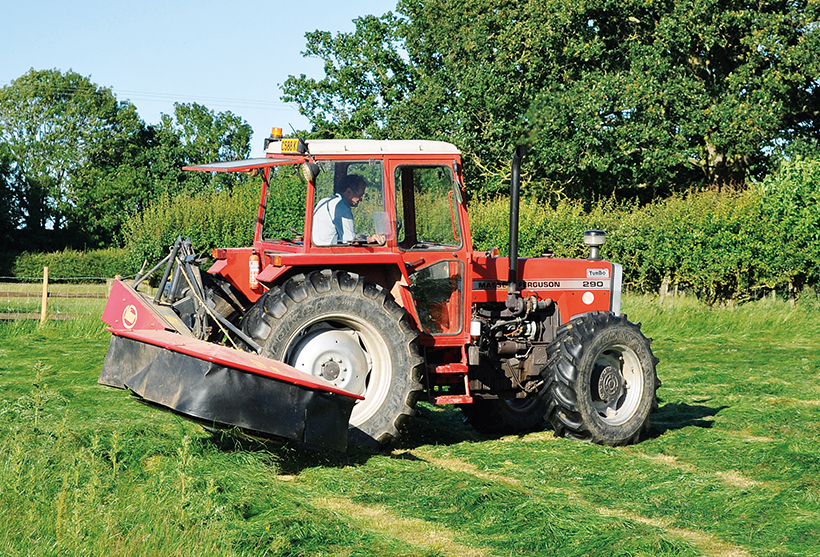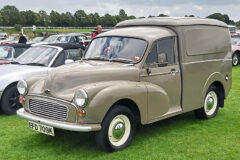1985 Massey Ferguson 290 still going strong!
Posted by Chris Graham on 14th November 2023
Scott Lambert chats to Richard Oliver about a 1985 Massey Ferguson 290, that’s proved to be the perfect tractor for a small livestock farm.
All photos: Richard Oliver

Philip and Richard Oliver’s 1985 Massey Ferguson 290 has been on the farm since 1993, and undertook a variety of tasks in its prime. It still cuts grass for hay today.
Introduced as the third model in the range, in 1981, the Massey Ferguson 290 would prove to be the second most popular tractor from the 200 Series (after the 265) thanks to its 75hp (DIN) output. It was a good all-rounder, capable of most jobs – especially on stock farms – and competitively marketed with a list price of £10,193 in February 1982.
A four-wheel-drive variant of the 290 was launched in July 1983, with a list price of £14,750, and this proved fashionable with those looking to increase productivity through better traction, as well as those with undulating land that would benefit from the sure-footedness that a driven front axle provides.
This MF 290 was supplied new by Shukers’ Ludlow branch and registered in 1985, but bought used from Morris Bufton & Co Ltd, in Ludlow, in October 1993. The tractor was bought by Philip and the late William Oliver of Whitehouse Farm, Bleathwood, Shropshire, for the sum of £6,750, after the previous owner traded it in against a Case IH model.
“This was the first four-wheel-drive we had bought, and it has always done the bulk of the field work on the farm since it arrived,” Richard Oliver told T&M. “At first it was run alongside an International B-275 and 454, but we have bought two tractors since the 290 – both loader tractors.

The Massey Ferguson 290 leads a more sedate life these days.
“We never really considered trading it in against a newer tractor to do the field work, due to its reliability. A newer tractor was viewed as having more things to go wrong and, as the years passed, we decided to stick with the 290, as we had maintained it ourselves and knew it so well.
“Our opinion is that the 290 is the perfect size and power for a small livestock farm like ours. The simplicity of the tractor, combined with the tried-and-tested design, is for us the reason it has been so dependable.”
The observant among you will have noted that the MF 290 is fitted with an aftermarket Holset turbocharger, which is believed to have been fitted from new, by Shukers. The turbo kit was supplied by TB Turbos Ltd, of Lancaster, and would have increased the power output of the tractor substantially. A similar kit marketed by OPICO, featuring an M&W turbo conversion, boasted an increase of 15hp.
With a long, five-inch stroke, and torque output of 198lb/ft as standard, the Perkins A4.248 was no slouch, but adding a turbo certainly gave it enviable performance. “The 290 doesn’t lack in power, and we’ve never felt that we have needed a more powerful tractor, as it’s handled whatever we have put it to do with ease,” explained Richard.

Several cabs were fitted to the MF 200 Series. This one was made by Alexander Duncan (Aberdeen) Ltd.
The power output of an engine is governed by several factors, one of which is the amount of air entering the cylinders and, in terms of the 290, it used a naturally-aspirated, four-cylinder unit, where the amount of air entering the engine was dependent on the design – in this case a bonnet-mounted pre-cleaner, and dual filter assembly behind the grille, cleaning the air before it was admitted to the engine.
The volume of air entering the engine dictates how much fuel is burned and, therefore, how much power is produced. Unless it has enough air to burn it efficiently, additional injected fuel will be wasted (think copious amounts of black smoke), and so it’s important to admit more air if you wish to create more power.
Compressor
By compressing the fresh air before it enters the cylinders, a greater volume of air can be introduced and, therefore, more fuel can be added too – meaning more power can be produced. A turbocharger is driven by an engine’s waste product – exhaust gases – and compresses the intake air, therefore enabling more to be admitted to the cylinders.
A turbo essentially comprises two halves – the inlet side and the exhaust side. Exhaust gases, that would usually exit through the silencer, are first channelled through the turbocharger’s turbine wheel. This usually spins at up to 250,000rpm, depending on the engine, and turns an impellor, via a shaft, inside the compressor on the inlet side of the turbocharger.

A Holset turbocharger was fitted as part of a TB Turbos Ltd kit when the tractor was new. Note how the bonnet was adapted to suit.
The role of the compressor is to squeeze the intake air that’s sucked in from the air cleaner, before it enters the cylinders. After spinning the turbine wheel, the exhaust gases exit via the exhaust pipe in the usual way.
The theory is that by enabling more air to enter the engine you have three main benefits. Firstly, as the intake air is at a higher pressure, it pushes the exhaust gases out of the cylinders. This is known as scavenging, and sees the burned gases ‘swept’ out of the cylinders with fresh air – improving the combustion in the next firing stroke. This ultimately means cleaner and more efficient combustion of fuel, lowering fuel costs.
Next, more air entering the engine means better cooling and, therefore, less wear – meaning increased longevity of components.
Lastly, and the main reason that most turbos are added, is the increase in power that fitting one delivers. Adding more air enables more fuel to be burned on each cycle – with the result being more power.

The panels are in good order, with the decals still legible.
Literature from the time that the 290 was fitted with a turbo suggests that, once such a kit had been added to the engine, the fuel pump could be recalibrated to inject approximately 15% more fuel to the cylinders.
Tractor manufacturers realised the benefits of turbocharging in the 1960s, but it didn’t become the norm until much later. Turbocharging was obviously the best way of increasing an engine’s power with minimal effort and, although some manufacturers chose to fit models with turbos at the factory, aftermarket options soon became a popular way of developing more power without hefty expenditure.
OPICO Ltd, of Lincolnshire, and TB Turbos Ltd, of Lancashire, were two of the main advocates of aftermarket turbocharging – offering numerous kits to suit tractors throughout the 1970s, ’80s, and ’90s.
In the case of this MF 290, TB Turbos Ltd would have issued a 1,200-hour guarantee, as the turbo kit was fitted by a recognised dealer, and correctly dynamometer-tested before and after the conversion was fitted to the new tractor. But, should it have been added to a used tractor, a six-month or 600-hour guarantee would have been offered.
The support was honoured “to the vehicle’s engine, subject to the operating procedures and duties employed” and the company expected those procedures to be adhered to during its working period.
Interestingly, literature from the company provided a useful guide that detailed before and after readings of a typical agricultural turbocharger conversion, based on the data provided by a Froment dynamometer, that was remarkably like the horsepower output of a Massey Ferguson 290.
‘Before’ readings claimed that the tractor produced 68hp at 956rpm and 421lb/ft of torque at the 1,000rpm PTO shaft, while ‘After’ measurements were 86hp (at 979rpm) and 516lb/ft – increases of 26.5 and 22.6% respectively. This would mean the MF 290 with its aftermarket turbo was producing more power than an MF 298 with a factory-fitted turbocharger, with a significant cost saving.
Soundtrack
One of the other ‘benefits’ of adding a turbocharger is the fitment of a ‘straight pipe’. There’s less back pressure on the engine and that lovely whistle emanates beautifully when the tractor’s in full song! The Olivers’ tractor is no different. “It makes a great sound with the turbo fitted, that a lot of people comment on. We refer to the 290 as ‘Turbo’ – a name that has stuck with neighbouring farmers, who still refer to the tractor by this same name.”

Other than the paint having been refinished on the wheels in 2014, the tractor is predominantly original
It’s not all about performance, though, as a tractor must enjoy minimal downtime if it’s to earn its keep and help maintain profitability. Fitting a turbo can lead to reliability concerns, especially if an engine wasn’t designed with turbocharging in mind. But the kit hasn’t caused problems in the time that Philip and Richard have owned the MF 290, or affected the reputation enjoyed by this range.
Like the 100 Series, the 200 Series has gained an enviable name for reliability over the years. The models may be no-
frills workhorses, but that doesn’t mean that corners were cut when they were built.
Whether you’re looking for a tractor to use at ploughing matches, a competent machine for your smallholding, or something out of the ordinary for your collection, the 290 doesn’t disappoint – it and its siblings were well designed and built to last.
Parts, genuine and aftermarket, new and used, are easily obtained, but don’t expect to do too much shopping, as consistency is one of the hallmarks of the 200 Series. “We’ve owned the tractor for close to 30 years now, and it’s never let us down,” Richard said. “The original hourmeter broke many years ago, at 5,872 hours, and unfortunately was never replaced – but approximately 12,000-plus hours have been covered to date.
“For 24 years, between 1993 and 2017, the 290 was in full-time use, and did all the muck-spreading, baling, mowing, hauling bales and the like, without fail. In that time, it has only needed regular servicing and maintenance, with the only new parts fitted being front wheel bearings, an alternator, a starter motor and a new seat.
“In 2014, we had the wheels sprayed and the tractor was freshened up cosmetically, including being deep-cleaned. This also tied in with Brimfield Vintage Club’s annual working day, which had a Massey Ferguson theme that year and was at a site only three miles away from the farm. Otherwise, the tractor is in its original condition.

The Vicon CM 188 two-drum mower is well within the capabilities of the MF 290.
“A family bereavement in 2016 led to most of the farm being rented out to a neighbouring farmer, and so the workload of the tractor these days is a lot lighter, but it still gets used alongside the same International B-275 as when it arrived, and a 2017 Kubota M5091 with LA1854 front-end loader, which does the majority of the work.
“The MF 290 is used each summer to mow for hay, and is regularly combined with a Teagle topper, as well as for other small tasks on the farm. The Duncan cab offers easy access and is a pleasant enough place in which to spend a day, although it’s basic by modern standards,” Richard concluded.
“It’s a tractor we certainly don’t regret buying, and don’t intend to sell any time soon!”
This feature comes from a recent issue of Tractor & Machinery, and you can get a money-saving subscription to this magazine simply by clicking HERE

Previous Post
Ripon Classic Car Gathering

Next Post
The fantastic classics on display at this year’s AEC Gathering



